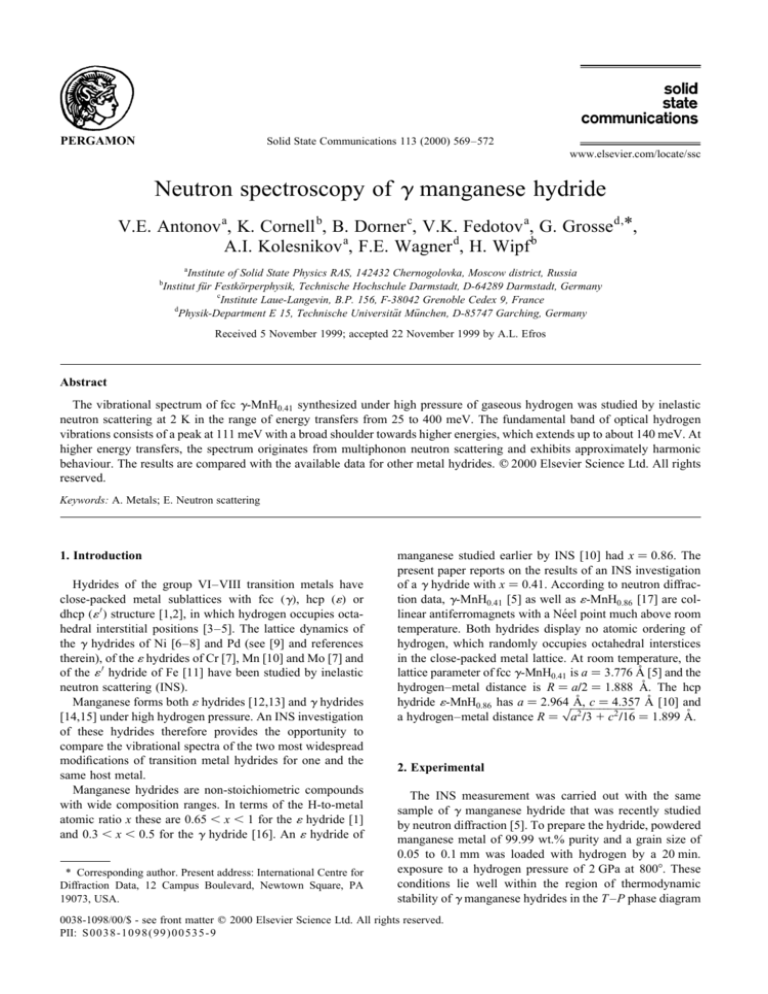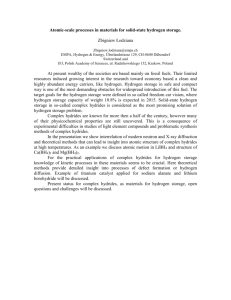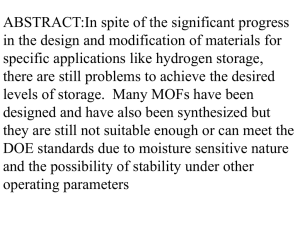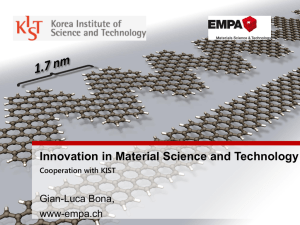
SSC 5070
PERGAMON
Solid State Communications 113 (2000) 569–572
www.elsevier.com/locate/ssc
Neutron spectroscopy of g manganese hydride
V.E. Antonov a, K. Cornell b, B. Dorner c, V.K. Fedotov a, G. Grosse d,*,
A.I. Kolesnikov a, F.E. Wagner d, H. Wipf b
a
b
Institute of Solid State Physics RAS, 142432 Chernogolovka, Moscow district, Russia
Institut für Festkörperphysik, Technische Hochschule Darmstadt, D-64289 Darmstadt, Germany
c
Institute Laue-Langevin, B.P. 156, F-38042 Grenoble Cedex 9, France
d
Physik-Department E 15, Technische Universität München, D-85747 Garching, Germany
Received 5 November 1999; accepted 22 November 1999 by A.L. Efros
Abstract
The vibrational spectrum of fcc g-MnH0:41 synthesized under high pressure of gaseous hydrogen was studied by inelastic
neutron scattering at 2 K in the range of energy transfers from 25 to 400 meV. The fundamental band of optical hydrogen
vibrations consists of a peak at 111 meV with a broad shoulder towards higher energies, which extends up to about 140 meV. At
higher energy transfers, the spectrum originates from multiphonon neutron scattering and exhibits approximately harmonic
behaviour. The results are compared with the available data for other metal hydrides. q 2000 Elsevier Science Ltd. All rights
reserved.
Keywords: A. Metals; E. Neutron scattering
1. Introduction
Hydrides of the group VI–VIII transition metals have
close-packed metal sublattices with fcc
g, hcp
1 or
dhcp
1 0 structure [1,2], in which hydrogen occupies octahedral interstitial positions [3–5]. The lattice dynamics of
the g hydrides of Ni [6–8] and Pd (see [9] and references
therein), of the 1 hydrides of Cr [7], Mn [10] and Mo [7] and
of the 1 0 hydride of Fe [11] have been studied by inelastic
neutron scattering (INS).
Manganese forms both 1 hydrides [12,13] and g hydrides
[14,15] under high hydrogen pressure. An INS investigation
of these hydrides therefore provides the opportunity to
compare the vibrational spectra of the two most widespread
modifications of transition metal hydrides for one and the
same host metal.
Manganese hydrides are non-stoichiometric compounds
with wide composition ranges. In terms of the H-to-metal
atomic ratio x these are 0:65 , x , 1 for the 1 hydride [1]
and 0:3 , x , 0:5 for the g hydride [16]. An 1 hydride of
* Corresponding author. Present address: International Centre for
Diffraction Data, 12 Campus Boulevard, Newtown Square, PA
19073, USA.
manganese studied earlier by INS [10] had x 0:86. The
present paper reports on the results of an INS investigation
of a g hydride with x 0:41. According to neutron diffraction data, g-MnH0:41 [5] as well as 1-MnH0:86 [17] are collinear antiferromagnets with a Néel point much above room
temperature. Both hydrides display no atomic ordering of
hydrogen, which randomly occupies octahedral interstices
in the close-packed metal lattice. At room temperature, the
lattice parameter of fcc g-MnH0:41 is a 3:776 Å [5] and the
hydrogen–metal distance is R a=2 1:888 Å. The hcp
hydride 1-MnH0:86 has a 2:964
Å, c 4:357
Å [10] and
p
a hydrogen–metal distance R a2 =3 1 c2 =16 1:899 Å.
2. Experimental
The INS measurement was carried out with the same
sample of g manganese hydride that was recently studied
by neutron diffraction [5]. To prepare the hydride, powdered
manganese metal of 99.99 wt.% purity and a grain size of
0.05 to 0.1 mm was loaded with hydrogen by a 20 min.
exposure to a hydrogen pressure of 2 GPa at 8008. These
conditions lie well within the region of thermodynamic
stability of g manganese hydrides in the T –P phase diagram
0038-1098/00/$ - see front matter q 2000 Elsevier Science Ltd. All rights reserved.
PII: S0038-109 8(99)00535-9
V.E. Antonov et al. / Solid State Communications 113 (2000) 569–572
of the Mn–H system [16]. Hot extraction and neutron
diffraction gave the same value of x 0:41 for the hydrogen
content of the sample.
The INS spectrum of a 390 mg sample of g-MnH0:41 was
measured at 2 K with the neutron spectrometer IN1 at the
hot source of the high flux reactor at the Institute LaueLangevin in Grenoble. The spectrometer was operated in
the beryllium filter mode, with a fixed scattering angle of
448. Cu(200) and Cu(220) monochromators were used to
obtain incoming neutrons with energies below and above
,120 meV, respectively. The corresponding energy resolutions were Dv=v < 7 % and 10 %.
The g-MnH0:41 powder sample was enclosed in a flat
aluminium container. A background spectrum from an
empty container was measured separately under the same
conditions and then subtracted from the raw INS spectrum
of the g-MnH0:41 sample in order to obtain the scattering
intensity from g-MnH0:41 alone.
γ-MnH0.41
S(Q,ω), arb. units
570
T=2K
0
0
100
200
300
400
ω , meV
Fig. 1. The dynamical structure factor S
Q; v of g-MnH0:41 as a
function of the energy loss v of the inelastically scattered neutrons.
The points connected by a solid line represent the data measured at
2 K with the IN1 BeF spectrometer at ILL, Grenoble. The dashed
line is the calculated multiphonon contribution.
The INS spectrum S
Q; v of g-MnH0:41 is shown in
Fig. 1. It originates nearly exclusively from neutron scattering on hydrogen atoms. The contribution from manganese
atoms is negligibly small, as the incoherent neutron scattering cross-section of H is about 40 times larger than that of
Mn [18]. Furthermore, in the case of optical vibrations the
scattering intensity is inversely proportional to the mass of
the atom, which is about 50 times smaller for H than for Mn.
With the hydrogen content x 0:41 of the sample, this
yields an intensity ratio of about 800 for scattering from H
and Mn in the g-MnH0:41 sample.
Significant inelastic scattering intensity from hydrogen is
observed in three energy regions around 111, 230 and
340 meV (Fig. 1). The feature around 111 meV consists of
a peak with a full width at half maximum of 12 meV, which
exceeds the energy resolution Dv < 8 meV, and of a large
shoulder towards higher energies, extending up to about
140 meV. The peak position and the shape of this intensity
distribution are typical of the fundamental band of optical
hydrogen vibrations in the 1 and g hydrides of 3d-metals
studied so far. The scattering intensities in the regions
around 230 < 2:111 meV and 340 < 3:111 meV can then
be attributed to multiphonon processes involving the
creation of two and three optical phonons, respectively.
of g-MnH0:41 at energies above 150 meV. The spectrum of
multiphonon scattering from this hydride thus exhibits
approximately harmonic behaviour. It seems rather probable, however, that similar to the case of fcc g-PdH [9],
this harmonic appearance is a result of averaging a highly
anisotropic and anharmonic spectrum of the single crystallites in the g-MnH0:41 powder over all orientations.
In [9], polycrystalline plates of g-PdH with strong texture
were studied by INS in two different orientations of the
sample, with the [100] axis of the texture parallel and at
an angle of 458 to the incoming neutron beam. The analysis
of the observed anisotropy of the high-energy part of the
INS spectrum showed that in the directions along the [110]
axis and close to the [111] axis, the potential well for hydrogen at the octahedral positions in the fcc metal lattice of PdH
is rather shallow and harmonic. Along the [100] axis, in the
direction towards the nearest Pd atom neighbour, it is
initially shallow too, but then very steep and strongly anharmonic. At the same time, the high-energy part of the INS
spectrum of a powder PdH sample studied in the same work
[9] exhibited only small deviations from the MPNS spectrum calculated in an isotropic harmonic approximation.
The character of the bonding of hydrogen in g-MnH0:41
and g-PdH being similar, one can expect that the main
features of the atomic potentials and, accordingly, of the
INS spectrum of g-MnH0:41 are the same as those of g-PdH.
3.1. Multiphonon scattering
3.2. The fundamental band of optical hydrogen vibrations
The estimated contribution from multiphonon neutron
scattering (MPNS) including processes involving up to
four phonons is shown as a dashed line in Fig. 1. The calculation was done by an iterative technique based on an isotropic and harmonic approximation [8,10]. As one can see from
Fig. 1, the calculated dashed line rather well describes the
main features of the multiphonon part of the INS spectrum
As can be seen in Fig. 1, multiphonon neutron scattering
significantly contributes to the intensity of the high-energy
shoulder of the main optical peak at 111 meV in the INS
spectrum of g-MnH0:41 . Nevertheless, the total intensity in
this range is much larger and the shoulder is also clearly
seen in the “one-phonon” spectrum shown in Fig. 2, which
was obtained by subtracting the calculated MPNS spectrum
3. Results and discussion
–3/2
ω0(R) = 414·R
0
100
125
ω , meV
150
γ-MnH0.41
ε-MnH0.86
0
meV
75
75
125
ω,
150
ε-MnH0.86
γ-NiH
–3/2
γ-PdH0.002
meV
from the experimental data. Such a shoulder is characteristic
of the INS spectra of all hydrides of the VI–VIII group
transition metals studied so far. Based on results for
palladium hydride [19,20], its occurrence is usually ascribed
to the dispersion of longitudinal optical phonon modes
caused by long-range repulsive H–H interactions.
Fig. 2 also shows the “one-phonon” spectrum of 1MnH0:86 obtained in [10] in the same way. As can be
seen, the positions of the main optical H peaks in the spectra
of g-MnH0:41 and 1-MnH0:86 coincide within the experimental error. In fact, even the whole intensity distributions of the
spectra coincide, if one takes into account that the spectrum
of 1-MnH0:86 was measured with a lower resolution. This is
shown in the inset of Fig. 2, where the spectrum of gMnH0:41 has been broadened to simulate this lower
resolution.
The similarity of the optical vibrational spectra of the fcc
and hcp hydrides of manganese allows the conclusion that in
general the position of the main hydrogen peak in the INS
spectra of d-metal hydrides with close-packed metal lattices
in which hydrogen occupies octahedral interstices does not
depend much on the particular structure of the hydride, fcc,
hcp or dhcp. It is therefore reasonable to consider the dynamical properties of all these hydrides jointly, as a function of
parameters applicable to every close-packed structure.
One such parameter is the hydrogen–metal distance R. In
the case of the dihydrides with a close-packed fluorite-type
structure (an fcc metal lattice with hydrogen on tetrahedral
interstices) formed by various d transition metals, rare
earths and even alkali earths, the energy of the main optical
hydrogen peak as a function of R well obeys the dependence
v0
R A·R23=2 [21]. Fig. 3 shows these data together with
the available data on v0
R for the transition metal monohydrides with close-packed structures.
As one can see from Fig. 3, the v0
R values of the monohydrides show a quite different behaviour than those of the
dihydrides. They steeply increase with decreasing atomic
ε-MoH
ε'-FeH
175
Fig. 2. The “one-phonon” INS spectra S
Q; v of g-MnH0:41 at 2 K
(open circles, data of the present work) and of 1-MnH0:86 at 100 K
(solid circles, data of Ref. [10]). The inset shows the same data, but
the spectrum of g-MnH0:41 has been broadened to simulate the
lower resolution of the measurement on the 1-MnH0:86 sample.
ε-CrH
120 γ-MnH
0.41
80
100
571
160
ω0 ,
S( Q, ω ), arb. units
S( Q, ω ), arb. units
V.E. Antonov et al. / Solid State Communications 113 (2000) 569–572
γ-PdH0.63
40
1.8
2.0
ω0(R) = 186·R
γ-PdH
2.2
2.4
2.6
R, Å
Fig. 3. Energy of the main optical hydrogen peak v0 vs. the distance
R between the nearest hydrogen and metal atoms for various dihydrides (crosses) [21] and for monohydrides of 3d-metals (open
circles) and 4d-metals (solid circles): 1-CrH [7], 1-MnH0:86 [10],
g-MnH0:41 — the present work, 1 0 -FeH [11], g-NiH [8], 1-MoH [7],
g-PdH [9], g-PdH0:63 [22] and g-PdH0:002 [22]. The upper dashed
curve is a least-squares fit to the data for the dihydrides, the lower
dashed curve has been included for comparison.
number of the host metal and, correspondingly, with
increasing R, and are significantly different for 3d- and
4d-metals. At the same time, the v0
R values for fcc g
hydrides of Pd with different hydrogen concentrations 1
decrease with increasing R, but much more steeply than
the v0 / R23=2 dependence valid for the dihydrides.
The factors resulting in the v0 A·R23=2 dependence
common for all the fluorite-type dihydrides are not well
understood yet. What can be said is that the increase in R
by itself should decrease the strength of the interatomic
interaction in a hydride and should therefore decrease v0 .
The opposite behaviour of the v0
R values of the monohydrides with decreasing atomic number of the host metal
(Fig. 3) therefore indicates a significant increase in the
hydrogen–metal interaction in the series of the 3d-metals
Ni ! Fe ! Mn ! Cr and also of the 4d-metals Pd ! Mo.
This effect agrees with predictions of first-principles calculations [23,24] that the reduction of the number of valence
electrons from right to left along the transition metal rows in
the periodic table should lead to a steepening of the potential
well for interstitial hydrogen due to a less efficient screening
of the ionic core charges.
4. Conclusions
The INS investigation showed that the fundamental band
of optical hydrogen vibrations in the fcc manganese hydride
1
The fcc hydrides of palladium depleted and rich in hydrogen are
often called the a and b phase, respectively.
572
V.E. Antonov et al. / Solid State Communications 113 (2000) 569–572
with x 0:41 extends over an energy interval from 90 to
140 meV and consists of a peak at 111 meV with a broad
shoulder towards higher energies. The peak position and the
shape of the intensity distribution are typical of fcc and hcp
hydrides of 3d transition metals and coincide with those of
the hcp manganese hydride with x 0:86. The similarity of
the optical vibrational spectra of the fcc and hcp manganese
hydrides suggests that the main factors which determine the
hydrogen dynamics are common to all close-packed crystal
modifications of monohydrides of transition metals. The
available data on the energy of the main optical H peak as
a function of the hydrogen–metal distance indicate a significant increase in the metal–hydrogen interaction in such
hydrides with decreasing atomic number of the host metal.
[8]
[9]
[10]
[11]
[12]
[13]
Acknowledgements
[14]
This work was supported by the Grants No. 99-02-17299
and 96-15-96806 from the Russian Foundation for Basic
Research.
[15]
[16]
References
[1] E.G. Ponyatovsky, V.E. Antonov, I.T. Belash, Problems in
Solid-State Physics, in: A.M. Prokhorov, A.S. Prokhorov
(Eds.), Mir Publishers, Moscow, 1984, p. 109.
[2] V.E. Antonov, I.T. Belash, V.F. Degtyareva, D.N.
Mogilyansky, B.K. Ponomarev, V.Sh. Shekhtman. Int. J.
Hydrogen Energy 14 (1989) 371.
[3] V.A. Somenkov, V.P. Glazkov, A.V. Irodova, S.Sh. Shilstein,
J. Less-Common. Metals, 129 (1987) 17.
[4] V.E. Antonov, K. Cornell, V.K. Fedotov, A.I. Kolesnikov,
E.G. Ponyatovsky, V.I. Shiryaev, H. Wipf, J. Alloys Compds
264 (1998) 214.
[5] V.K. Fedotov, V.E. Antonov, A.I. Kolesnikov, A.I.
Beskrovnyi, G. Grosse, F.E. Wagner, Solid State Commun.
107 (1998) 787.
[6] J. Eckert, C.F. Majkzrak, L. Passell, W.B. Daniels, Phys. Rev.
B 29 (1984) 3700.
[7] B. Dorner, I.T. Belash, E.L. Bokhenkov, E.G. Ponyatovsky,
[17]
[18]
[19]
[20]
[21]
[22]
[23]
[24]
V.E. Antonov, L.N. Pronina, Solid State Commun. 69 (1989)
121.
A.I. Kolesnikov, I. Natkaniec, V.E. Antonov, I.T. Belash,
V.K. Fedotov, J. Krawczyk, J. Mayer, E.G. Ponyatovsky,
Physica B 174 (1991) 257.
D.K. Ross, V.E. Antonov, E.L. Bokhenkov, A.I. Kolesnikov,
E.G. Ponyatovsky, J. Tomkinson, Phys. Rev. B 58 (1998)
2591.
V.E. Antonov, I.T. Belash, A.I. Kolesnikov, J. Mayer, I.
Natkaniec, E.G. Ponyatovskii, V.K. Fedotov, Sov. Phys.
Solid State 33 (1991) 87.
K. Cornell, H. Wipf, V.E. Antonov, T.E. Antonova, A.I.
Kolesnikov, E.G. Ponyatovsky, B. Dorner, Polish J. Chem.
71 (1997) 1792.
M. Krukowski, B. Baranowski, Roczniki Chem. 49 (1975)
1183.
E.G. Ponyatovskii, I.T. Belash, Dokl. Akad. Nauk SSSR 224
(1975) 607 (in Russian).
Y. Fukai, H. Ishikawa, T. Goto, J. Susaki, T. Yagi, J.L.
Soubeyroux, D. Fruchart, Z. Phys. Chem. N. F. 163 (1989)
479.
S.M. Filipek, S. Majchrzak, A.B. Sawaoka, M. Cernansky,
High Pressure Research 7 (1991) 271.
V.E. Antonov, T.E. Antonova, N.A. Chirin, E.G.
Ponyatovsky, M. Baier, F.E. Wagner, Scripta Mat. 34
(1996) 1331.
A.V. Irodova, V.P. Glazkov, V.A. Somenkov, S.Sh.
Shil’shtein, V.E. Antonov, Ponyatovskii, Sov. Phys. Solid
State 29 (1987) 1562.
V.F. Sears, Neutron News 3 (1992) 26.
J.M. Rowe, J.J. Rush, H.G. Smith, M. Mostoller, H.E. Flotow,
Phys. Rev. Lett. 33 (1974) 1297.
A. Rahman, K. Sköld, C. Pelizzari, S.K. Sinha, H.E. Flotow,
Phys. Rev. B 14 (1976) 3630.
D.K. Ross, P.F. Martin, W.A. Oates, R. Khoda Bakhsh,
Z. Phys. Chem. N. F. 114 (1979) 221.
J.J. Rush, J.M. Rowe, D. Richter, Z. Phys. B Condens. Matter
55 (1984) 283.
C. Elsässer, H. Krimmel, M. Fähnle, S.G. Louie, C.T. Chan,
J. Phys.: Condens. Matter 10 (1998) 5131.
C. Elsässer, Ab-initio-Elektronentheorie für ÜbergangsmetallWasserstoff-Verbindungen, Habilitationsschrift, Universität
Stuttgart, 1994.



![DIRECT SYNTHESIS OF Li[BH4] FROM THE ELEMENTS](http://s3.studylib.net/store/data/006749722_1-3acc3b7e04414ccf23cb4364d250a1e7-300x300.png)




